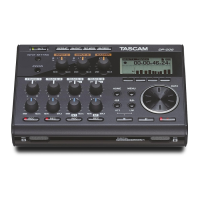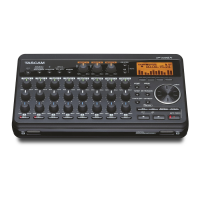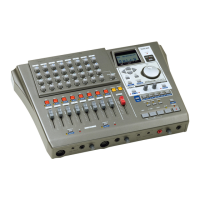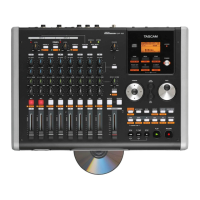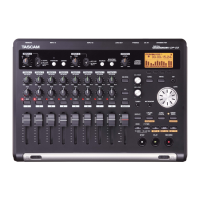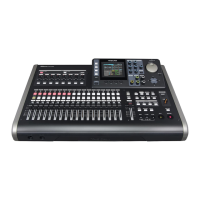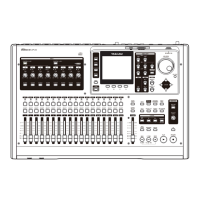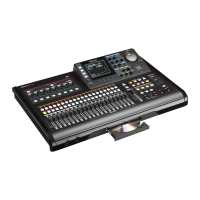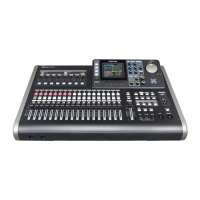Do you have a question about the Tascam DP-008 and is the answer not in the manual?
Precautions for handling and using batteries to prevent hazards like leaks, ruptures, or fires.
Explains document conventions, symbols, and lists package contents.
Covers trademarks, SD card compatibility, and general handling precautions.
Guidelines for unit placement, avoiding condensation, and cleaning the device.
Guides for basic playback, mixing, and listening to the demo song.
Overview of multitrack recording, creating new songs, and connecting inputs.
Step-by-step instructions for recording guitar and vocals onto tracks.
Process of adjusting levels, panning, and creating a stereo master track.
Procedure for safely powering off the DP-008.
Description of buttons, knobs, and indicators on the top panel.
Description of controls and features on the front panel.
Details on all input/output jacks and switches on the rear panel.
Description of ports on the side panel and battery compartment.
Explanation of the main display screen and its indicators.
Steps for inserting SD card and installing AA batteries.
Connecting AC adapter and procedures for powering on/off.
How to format SD cards and select recorder modes.
Connecting external devices and adjusting screen contrast.
Adjusting the LCD backlight duration for power saving.
Understanding SD card partitions and selecting the active one.
Procedures for naming, loading, creating, and saving song projects.
Checking song details, copying songs, and deleting unwanted ones.
How to prevent songs from being edited, recorded, or erased.
Configuring input sources and enabling phantom power.
Listening to input signals and understanding meter indicators.
Setting input sources for tracks and adjusting input equalization.
Step-by-step guide to making a basic recording.
Recording multiple tracks, adjusting parameters, and creating a stereo mix.
Applying equalization and reverb effects to individual tracks.
How to mute or unmute individual tracks.
Defining the end point and recording the final stereo master track.
Using undo functions and clearing the operation history.
Techniques for replacing audio parts and using a foot switch.
Mixing multiple tracks down to one or two destination tracks.
Navigating songs, searching, and setting up repeat playback.
How to set, capture, and adjust IN/OUT points for playback and editing.
Using automatic punch operations and practicing them.
Lists editing functions and explains IN, OUT, and TO editing points.
How to copy, insert, and move audio data between tracks.
How to insert silence, cut parts, erase sections, and duplicate tracks.
Completely erasing a selected track.
Using the built-in metronome and chromatic tuner.
Using the oscillator and configuring auto power-off.
Resetting preferences and checking unit information.
Understanding SD card partitions and formatting the card.
Reformatting MTR/FAT partitions and initializing the entire card.
Lists compatible operating systems and how to connect via USB.
Safe procedures for disconnecting the unit from a computer.
Backing up/restoring songs and transferring tracks to/from a PC.
How to export the final stereo mix to a computer.
Troubleshooting steps for when no sound is heard during playback.
Addressing distorted recordings and general recording failures.
Troubleshooting why a computer cannot detect unit files.
Technical details on audio connections and performance metrics.
Details on media, file system, power, and computer system needs.
Physical dimensions, optional accessories, and the unit's block diagram.
Precautions for handling and using batteries to prevent hazards like leaks, ruptures, or fires.
Explains document conventions, symbols, and lists package contents.
Covers trademarks, SD card compatibility, and general handling precautions.
Guidelines for unit placement, avoiding condensation, and cleaning the device.
Guides for basic playback, mixing, and listening to the demo song.
Overview of multitrack recording, creating new songs, and connecting inputs.
Step-by-step instructions for recording guitar and vocals onto tracks.
Process of adjusting levels, panning, and creating a stereo master track.
Procedure for safely powering off the DP-008.
Description of buttons, knobs, and indicators on the top panel.
Description of controls and features on the front panel.
Details on all input/output jacks and switches on the rear panel.
Description of ports on the side panel and battery compartment.
Explanation of the main display screen and its indicators.
Steps for inserting SD card and installing AA batteries.
Connecting AC adapter and procedures for powering on/off.
How to format SD cards and select recorder modes.
Connecting external devices and adjusting screen contrast.
Adjusting the LCD backlight duration for power saving.
Understanding SD card partitions and selecting the active one.
Procedures for naming, loading, creating, and saving song projects.
Checking song details, copying songs, and deleting unwanted ones.
How to prevent songs from being edited, recorded, or erased.
Configuring input sources and enabling phantom power.
Listening to input signals and understanding meter indicators.
Setting input sources for tracks and adjusting input equalization.
Step-by-step guide to making a basic recording.
Recording multiple tracks, adjusting parameters, and creating a stereo mix.
Applying equalization and reverb effects to individual tracks.
How to mute or unmute individual tracks.
Defining the end point and recording the final stereo master track.
Using undo functions and clearing the operation history.
Techniques for replacing audio parts and using a foot switch.
Mixing multiple tracks down to one or two destination tracks.
Navigating songs, searching, and setting up repeat playback.
How to set, capture, and adjust IN/OUT points for playback and editing.
Using automatic punch operations and practicing them.
Lists editing functions and explains IN, OUT, and TO editing points.
How to copy, insert, and move audio data between tracks.
How to insert silence, cut parts, erase sections, and duplicate tracks.
Completely erasing a selected track.
Using the built-in metronome and chromatic tuner.
Using the oscillator and configuring auto power-off.
Resetting preferences and checking unit information.
Understanding SD card partitions and formatting the card.
Reformatting MTR/FAT partitions and initializing the entire card.
Lists compatible operating systems and how to connect via USB.
Safe procedures for disconnecting the unit from a computer.
Backing up/restoring songs and transferring tracks to/from a PC.
How to export the final stereo mix to a computer.
Troubleshooting steps for when no sound is heard during playback.
Addressing distorted recordings and general recording failures.
Troubleshooting why a computer cannot detect unit files.
Technical details on audio connections and performance metrics.
Details on media, file system, power, and computer system needs.
Physical dimensions, optional accessories, and the unit's block diagram.
| Type | Digital Multitrack Recorder |
|---|---|
| Tracks | 8 |
| Simultaneous Recording Tracks | 2 |
| Simultaneous Playback Tracks | 8 |
| Line Inputs | 2 |
| Storage Media | SD/SDHC Card |
| Effects | Reverb |
| Inputs | 2 x XLR / 1/4" combo jacks |
| Headphone Output | 1 x 1/8" |
| Phantom Power | Yes |
| USB Port | Mini-B type |
| Power Supply | AA Batteries x 4 / Optional AC Adapter (TASCAM PS-P520E) |
